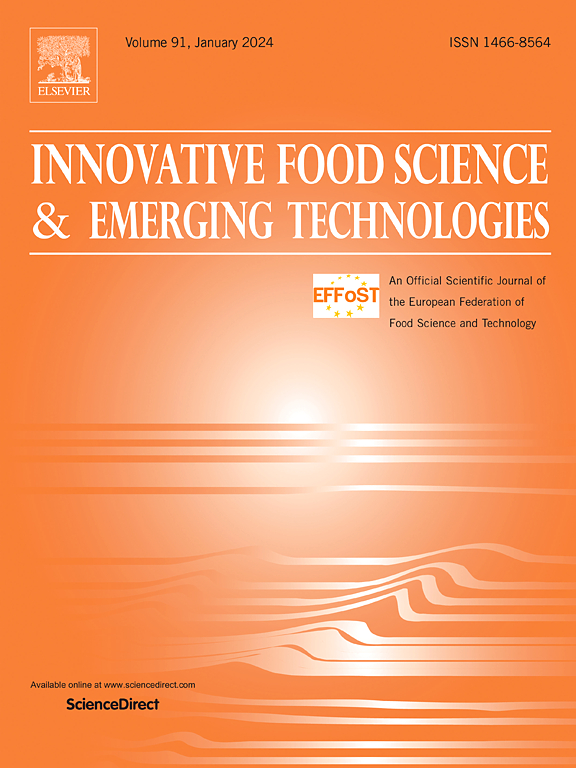Valorization of second cheese whey enriched with apple pomace for the production of innovative fermented products
IF 6.8
1区 农林科学
Q1 FOOD SCIENCE & TECHNOLOGY
Innovative Food Science & Emerging Technologies
Pub Date : 2025-06-15
DOI:10.1016/j.ifset.2025.104086
引用次数: 0
Abstract
Second cheese whey (SCW) is the primary by-product of the whey processing, which has received particular attention due to its significant environmental impact as a source of pollution. Due to its compositional profile and richness in lactose, SCW is an underexplored by-product and its valorization is not widely practiced being difficult to manage. This study aimed to exploit SCW as a potential ingredient for the development of new food products, such as enriched dairy products. To achieve this goal, twelve fermented formulations were produced and compared using milk, SCW, and their 50:50 mixture as substrates for fermentation. Three lactic bacterial (LAB) strains were selected, and the effect of apple pomace (AP), a by-product of juice processing, incorporated into the substrates during fermentation was investigated. The results showed that the growth of LAB was enhanced in the presence of AP, and a progressive increase in the total phenolic content and antioxidant activity was observed as the percentage of AP increased from 4 % to 12 %. HPLC analysis, in particular, revealed elevated concentrations of quercetin glycosylated derivatives in SCW-based fermented products, with the highest levels observed in samples containing 12 % AP. A chemometric approach was applied to identify groupings within the dataset. Strong correlations were consistently found between spectrophotometric assays and the polyphenol concentration measured by chromatography. Furthermore, the sensory evaluation results confirmed a higher overall acceptability score for products fermented with SCW and 12 % AP.
苹果渣二次奶酪乳清的增值生产创新发酵产品
第二奶酪乳清(SCW)是乳清加工的主要副产品,由于其作为污染源对环境的重大影响而受到特别关注。由于其在乳糖中的成分和丰富程度,SCW是一种未被充分开发的副产品,其定价也没有广泛实践,难以管理。本研究旨在利用SCW作为一种潜在的成分来开发新的食品,如强化乳制品。为了实现这一目标,我们制作了12种发酵配方,并以牛奶、硫酸渣及其50:50的混合物为发酵底物进行了比较。选择3株乳酸菌(LAB),研究了果汁加工副产物苹果渣(AP)在发酵过程中掺入底物的效果。结果表明,AP的存在促进了乳酸菌的生长,随着AP含量从4%增加到12%,总酚含量和抗氧化活性逐渐增加。HPLC分析尤其显示,在scw发酵产品中槲皮素糖基化衍生物的浓度升高,在含有12% AP的样品中观察到的浓度最高。采用化学计量学方法确定数据集中的分组。分光光度法测定的多酚浓度与色谱法测定的多酚浓度具有很强的相关性。此外,感官评价结果证实,添加SCW和12% AP发酵的产品总体可接受性得分较高。
本文章由计算机程序翻译,如有差异,请以英文原文为准。
求助全文
约1分钟内获得全文
求助全文
来源期刊
CiteScore
12.00
自引率
6.10%
发文量
259
审稿时长
25 days
期刊介绍:
Innovative Food Science and Emerging Technologies (IFSET) aims to provide the highest quality original contributions and few, mainly upon invitation, reviews on and highly innovative developments in food science and emerging food process technologies. The significance of the results either for the science community or for industrial R&D groups must be specified. Papers submitted must be of highest scientific quality and only those advancing current scientific knowledge and understanding or with technical relevance will be considered.

 求助内容:
求助内容: 应助结果提醒方式:
应助结果提醒方式:


